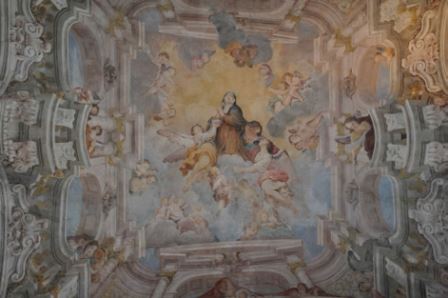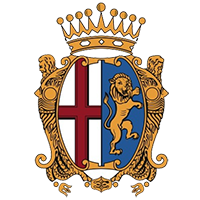
G. Battista e C. Pozzo (attr.), Gloria di Santa Marta, fine XVII secolo, affresco
Nota già dal XIII secolo e dedicata in origine a San Calimero, prima del 1386 divenne sede della confraternita dei Disciplini di Santa Marta, con annesso ospizio, mutandone così anche la dedicazione.
Le più importanti trasformazioni che interessarono l'edificio avvennero alla fine del Quattrocento e all'inizio del Seicento, mentre la facciata, innestata su un leggero porticato, fu realizzata tra il 1720 e il 1730.
L'interno, a una sola navata, e ampio presbiterio, presenta nella volta a botte un notevole affresco tardo-seicentesco, con la Gloria di Santa Marta attribuito a Giovan Battista e Carlo Pozzo.
Formelle intagliate con i busti degli apostoli del sec. XVI decorano la base dell'altare in finto marmo, realizzato nel 1816 presumibilmente su progetto di Giuseppe Bovara.
Nell'ancona sopra l'altare maggiore è collocata la statua seicentesca della Madonna del Rosario con il bambino benedicente, impreziosita da ricche vesti, portata nella processione penitenziale del 1630.
Le nicchie laterali accolgono le statue di Santa Marta e San Antonio di Padova.
![]() Church of Saint Martha
Church of Saint Martha
The church was already known in the 13th century and it was originally dedicated to St. Calimero.
In 1386 it became the seat of the Confraternity of the Disciplini of St. Martha. A hospice was added and the church dedicated to the Saint.
It underwent several changes: at the end of the 15th century, at the beginning of the 17th and 18th century.
Inside the church, there is a remarkable fresco by Giovan Battista and Carlo Pozzo on the vault and a 17th century statue of the Lady of the Rosary.
Church of Saint Martha The church was already known in the 13th century and it was originally dedicated to St. Calimero.
In 1386 it became the seat of the Confraternity of the Disciplini of St. Martha.
A hospice was added and the church dedicated to the Saint.
It underwent several changes: at the end of the 15th century, at the beginning of the 17th and 18th century. Inside the church, there is a remarkable fresco by Giovan Battista and Carlo Pozzo on the vault and a 17th century statue of the Lady of the Rosary.

